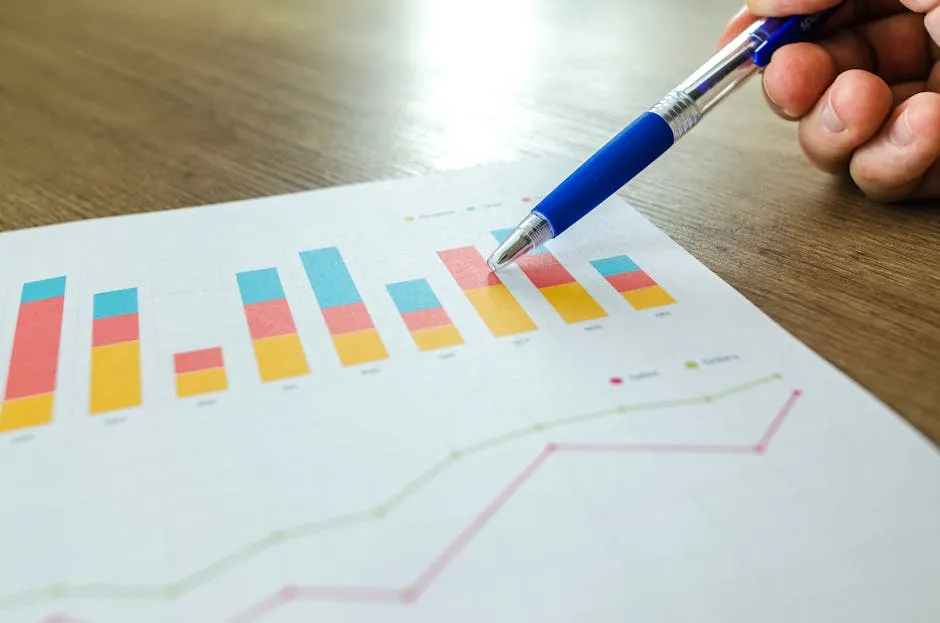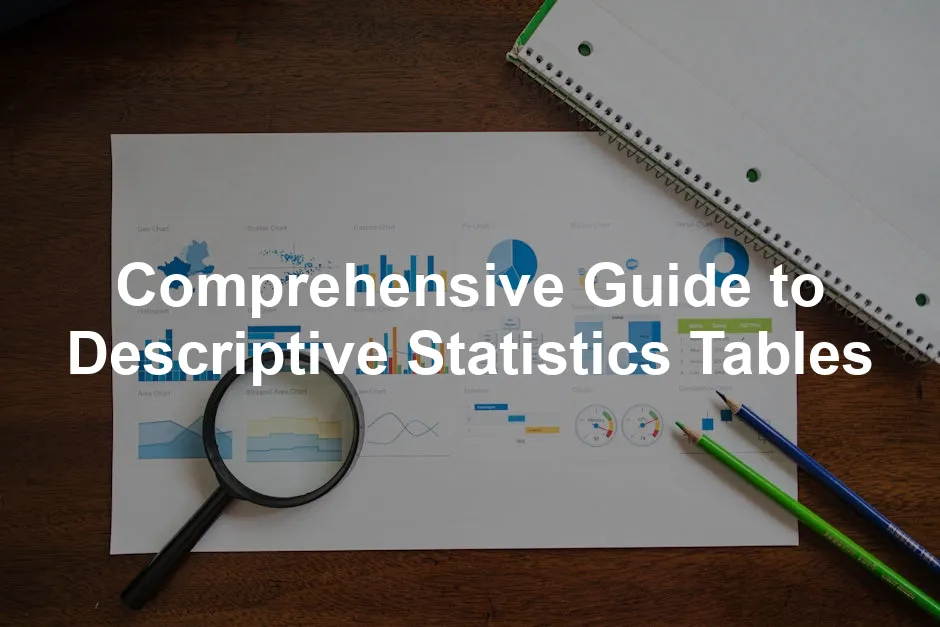Introduction
Descriptive statistics are the unsung heroes of data analysis. They provide a snapshot of data, making it digestible and understandable. Think of them as the appetizers before the main course—easy to consume yet incredibly informative. By summarizing large datasets, descriptive statistics help researchers, analysts, and decision-makers glean insights without needing to sift through every single data point.
At the heart of descriptive statistics is the descriptive statistics table. This table acts as a powerful tool, converting rows of numbers into clear, concise summaries. It typically showcases key metrics such as mean, median, mode, standard deviation, and range. Why is this crucial? Because it allows for quick comparisons and understanding of data distributions across various contexts. Whether you’re analyzing survey data, academic research, or company performance metrics, these tables are indispensable.
So, if you want to dive deeper into statistical analysis, consider grabbing a copy of Statistical Analysis with Excel For Dummies. It’s a fantastic resource that breaks down complex concepts into bite-sized pieces, perfect for beginners and seasoned analysts alike.
Descriptive statistics tables find their home in numerous settings. In research, they summarize findings, facilitating easier interpretation of results. Businesses rely on them to track performance indicators, sales figures, or customer satisfaction levels. Even in academic reporting, these tables are vital for presenting data in a standardized format.

So, buckle up! In the sections that follow, we will dive into the nitty-gritty of descriptive statistics tables. We’ll cover their components, how to create them, and the tools you can use to generate these tables efficiently. By the end, you’ll be equipped with the knowledge to effectively summarize and present your data like a pro.
Understanding Descriptive Statistics
Definition and Importance
Descriptive statistics summarize and describe the main features of a dataset. They transform raw data into meaningful insights using a few key metrics. Among these metrics, the most commonly used include mean, median, mode, standard deviation, and range.
The mean is the average value, calculated by summing all values and dividing by the count. It’s useful for understanding the central tendency but can be skewed by outliers. In contrast, the median represents the middle value when data points are arranged in order. It’s particularly helpful when dealing with skewed distributions, as it is less affected by extreme values. For a deeper understanding of the median, check out the insights on statistics Poland median salary 2024.
Understanding the median can help in analyzing skewed data distributions effectively. Statistics Poland median salary 2024 provides a detailed look into this metric.
The mode, on the other hand, identifies the most frequently occurring value in a dataset. It’s especially beneficial in categorical data analysis where you want to know the most common category. The standard deviation measures the amount of variation or dispersion in a set of values. A low standard deviation indicates that data points are close to the mean, while a high standard deviation shows that they are spread out over a wider range.
Lastly, the range provides insight into the spread of data by subtracting the minimum value from the maximum. This is often the first step in data exploration, giving a quick view of the variability in your dataset.
Understanding these components is crucial. Descriptive statistics make data analysis more approachable, allowing researchers and businesses to draw conclusions without deep statistical knowledge. They serve as the foundation for more complex analyses, helping identify trends, patterns, and anomalies within the data. Plus, they equip you to communicate findings effectively, making your reports and presentations more impactful.

Types of Descriptive Statistics
When we talk about descriptive statistics, we can’t ignore the distinction between continuous and categorical variables. Continuous variables can take any value within a range. Think height, weight, or temperature. For example, the height of a group of people can vary from 150 cm to 200 cm. Categorical variables, on the other hand, represent distinct groups or categories. They include variables like gender, race, or the type of car someone drives. For instance, a survey might categorize respondents into groups: male, female, or non-binary.
Now, let’s break down some key measures used in descriptive statistics.
- Mean: This is the average of a dataset. Calculated by adding all values and dividing by the number of observations. For a more detailed definition, refer to the article on what does mean identically distributed in statistics.
- Median: The middle value when data points are ordered. If the dataset has an even number of observations, the median is the average of the two middle numbers. It’s great for understanding central tendency, especially in skewed distributions.
- Mode: This is the most frequently occurring value in a dataset. It’s particularly useful in categorical data. For example, if you survey people about their favorite ice cream flavor, the mode tells you which flavor is the crowd favorite.
- Range: This captures the spread of data. It’s calculated by subtracting the smallest value from the largest. A wider range indicates greater variability.
- Variance: This measures how far each number in the dataset is from the mean. It’s calculated by averaging the squared differences from the mean. A high variance indicates that the data points are widely spread out.
- Standard Deviation: This is simply the square root of variance. It provides insight into how much individual data points deviate from the mean. A low standard deviation means that the data points tend to be close to the mean.
- Interquartile Range (IQR): This measures the middle 50% of a dataset. Calculated by subtracting the first quartile (25th percentile) from the third quartile (75th percentile), the IQR is essential for understanding the spread of the central portion of the data.
Speaking of understanding data, if you’re interested in diving deeper into data science concepts, check out Data Science for Business: What You Need to Know about Data Mining and Data-Analytic Thinking. It’s a great resource for understanding how to leverage data in decision-making.

Creating Descriptive Statistics Tables
Step-by-Step Guide
Creating a descriptive statistics table is like assembling a puzzle. Each piece needs to fit just right. Whether you’re doing it manually or using software, let’s walk through the process.
- Identify Your Data: Start by selecting the dataset you want to analyze. Ensure it’s clean and well-organized.
- Choose Your Variables: Decide which variables are significant for your analysis. For example, if you’re studying income levels, you might want the variables: age, income, education level, and location.
- Calculate Descriptive Statistics: Compute the mean, median, mode, range, variance, standard deviation, and IQR for your variables. You can do this manually, but software tools make it easier.
- Assemble the Table: Structure your table with rows for each variable and columns for each statistic. Label everything clearly.
- Review and Adjust: Ensure the table aligns with your analysis goals. Adjust any formatting for clarity.
For those looking to enhance their Excel skills, grab a copy of Excel 2021 for Dummies. It’s a fantastic resource to help you navigate through the various features of Excel, making data analysis a breeze!
Using Stata
Stata offers a user-friendly way to generate descriptive statistics tables. Here’s how:
Commands: Use the summarize, table, and dtable commands. For instance, to get summary statistics for age and income, run:
summarize age incomeExample Code:
webuse nhanes2l, clear
dtable age weight bpsystol i.sex i.race, by(diabetes) export(table1.html, replace)This command generates a detailed table, exporting it in HTML format. Easy-peasy!
Using R
R is a powerhouse for statistical analysis. You can create descriptive statistics tables using packages like dplyr, vtable, and psych.
Example Code:
library(dplyr)
data(mtcars)
mtcars %>% summarise(
mean_mpg = mean(mpg),
median_mpg = median(mpg),
sd_mpg = sd(mpg)
)This snippet calculates the mean, median, and standard deviation of miles per gallon (mpg) for the mtcars dataset.
Using vtable:
library(vtable)
sumtable(mtcars)This command generates a formatted summary statistics table showcasing key metrics.
By following these steps in Stata and R, you can create elegant descriptive statistics tables that summarize your data effectively.
With this knowledge, you’re armed to tackle data analysis like a pro! So roll up your sleeves and start building those tables.

Customizing Descriptive Statistics Tables
Formatting Options
Creating a readable descriptive statistics table is an art form. It’s not just about numbers; it’s about making those numbers look pretty! Here’s how to enhance your table’s readability with some snazzy formatting options.
- Font Styles: Choose a font that’s easy on the eyes. Sans-serif fonts like Arial or Verdana are excellent choices. Use bold for headers and keep body text regular. This contrast helps highlight key data without overwhelming the reader.
- Colors: Use color wisely. Highlight the header row with a soft background color to make it pop. Avoid using too many colors, as it can turn your table into a carnival. Stick to a palette of two or three colors for a clean look.
- Borders: Use borders to separate sections of your table. A simple line beneath the header row can help guide the reader’s eye. Too many lines can clutter your table, so keep it simple—less is often more.
- Alignment: Align numbers to the right for consistency and better readability. Text can be left-aligned to distinguish it from numerical data. This subtle shift can significantly improve the overall look of your table.
- Spacing: Don’t cram your data together. Use adequate spacing between rows and columns. This helps prevent visual fatigue and makes it easier for readers to skim through your data.
By implementing these formatting options, your descriptive statistics table will not only convey information but also engage your readers. It’s all about making the data accessible and enjoyable to digest!

Adding Additional Statistics
Now that we’ve jazzed up our table, let’s talk about adding more stats! Customizing tables to include additional statistics or group comparisons can elevate your data presentation to new heights.
- Including Extra Statistics: Sometimes, you might want to display additional statistics, like the interquartile range (IQR) or the mode. In Minitab, for instance, you can modify your options to include these metrics. This extra layer of detail can provide a deeper understanding of your data distribution.
- Group Comparisons: Group comparisons can be invaluable when analyzing data across different categories. For example, if you’re comparing test scores between different classes, create columns for each class. Calculating means, standard deviations, and counts for each group helps highlight differences and similarities.
- Example of Complex Tables: Imagine a table where you compare test scores across three different regions, including means and standard deviations. One row could represent the average score for each region, while additional rows show the standard deviation. This format allows for quick visual comparisons.
| Region | Mean Score | Standard Deviation |
|---|---|---|
| North | 85 | 5 |
| South | 78 | 6 |
| East | 82 | 4 |
| West | 90 | 3 |
4. Visual Enhancements: Use conditional formatting to highlight high or low values. For instance, you could color-code the mean scores to make it easier to identify which region performed best. This visual cue enhances comprehension in an instant.
By customizing your descriptive statistics tables to include additional statistics and group comparisons, you enhance the depth of your analysis. It transforms a simple data table into a powerful storytelling tool, making your findings more impactful and engaging for your audience.

Exporting and Sharing Tables
Exporting descriptive statistics tables is crucial for effective communication. Whether you need to share your findings in a report or present them in a meeting, knowing how to export your tables can save you time and hassle.
You can export tables in various formats, including Word, PDF, and HTML. Most statistical software, like Stata and R, offer built-in commands for this purpose. For example, in Stata, the export command allows you to save tables directly in your desired format. Similarly, R provides functions like knitr::kable() for creating HTML tables or write.csv() for exporting to Excel.
When sharing tables, consider your audience. Use clear titles and labels to enhance understanding. Ensure that the formatting is consistent and visually appealing. A well-structured table not only conveys information effectively but also keeps your audience engaged.
Best practices for sharing tables include providing context. Include a brief description of what the table represents. Highlight key findings or trends directly in the table or in accompanying text. This approach ensures that your audience grasps the significance of the data presented.

Common Mistakes and How to Avoid Them
Creating descriptive statistics tables can be a straightforward task, but it’s easy to trip over common pitfalls. Here are some typical errors and how to steer clear of them.
One frequent mistake is mislabeling data. Whether it’s confusing variable names or incorrect units, mislabeling can mislead readers. Always double-check your variable labels and ensure they accurately reflect the data they represent.
Another error is using inappropriate statistics. For instance, presenting the mean for a skewed distribution can be misleading. Instead, consider using the median or other robust measures. Be aware of your data’s characteristics—this ensures you choose the right descriptive statistics.
Clarity is key. Tables packed with numbers can overwhelm readers. Aim for simplicity. Use clean formatting, and avoid cluttering your tables with excessive details. Focus on presenting the essential statistics.
To ensure accuracy, double-check your calculations. It’s easy to make errors when computing statistics manually. Using software can reduce this risk, but always validate the output.
When presenting your tables, consider the audience. Tailor the complexity of your statistics to their knowledge level. If your audience is unfamiliar with certain terms or concepts, provide brief explanations or a glossary.
Lastly, ensure that your tables are accessible. Use clear fonts and appropriate sizes. If you’re sharing your tables digitally, ensure they are compatible with various devices and screen sizes.

In short, creating effective descriptive statistics tables requires attention to detail, clarity, and consideration of your audience. By avoiding these common mistakes, you can present your data confidently and effectively.
Conclusion
Descriptive statistics tables play a vital role in data analysis and reporting. They condense complex datasets into digestible summaries, making it easier for readers to grasp the key insights. By using these tables, you can enhance the clarity of your findings and facilitate better decision-making.
When creating your tables, remember to follow best practices. Accurate labeling, appropriate statistics, and clear formatting are essential. These elements not only improve comprehension but also enhance the overall presentation of your data.
Encouraging your readers to utilize descriptive statistics tables can empower them to analyze data effectively. Whether in research, business, or academia, these tables serve as powerful tools for summarizing information. So, roll up your sleeves and start creating those tables—your audience will appreciate the clarity and insight they provide!
FAQs
What is the purpose of a descriptive statistics table?
A descriptive statistics table serves as a powerful data summarization tool. It provides a concise overview of key statistical measures for a dataset. This includes essential metrics like mean, median, mode, standard deviation, and range. By presenting these statistics, the table allows readers to grasp the overall characteristics of the data at a glance. Think of it as a snapshot that highlights the central tendencies and variability of the dataset. For example, if you’re analyzing survey results, this table helps you quickly identify the average response and how varied the responses are. Overall, descriptive statistics tables transform raw data into meaningful insights, making them invaluable for researchers and analysts alike.
How do I choose which statistics to include in my table?
Selecting appropriate statistics for your table depends on the type of data you’re working with. For continuous variables, focus on metrics like mean, median, and standard deviation. These provide clear insights into central tendencies and variability. If your data includes categorical variables, consider including counts and percentages. For example, if you’re examining responses from a gender demographic, showing the number of males and females alongside their proportions can be informative. Remember, the goal is to convey essential information without overwhelming the reader. Keep your audience in mind. Choose statistics that align with their interests and the context of your analysis.
Can I create descriptive statistics tables using online tools?
Absolutely! Several online tools and software can help you create descriptive statistics tables effectively. For instance, platforms like Displayr, Q Research Software, and Minitab provide user-friendly interfaces for generating these tables. Most of these tools allow you to select variables, choose relevant statistics, and customize the output format. They also often include features for visualizing the data, making it easier to interpret. Whether you’re a seasoned analyst or a beginner, these tools streamline the process of summarizing data in a clear and accessible manner.
What software is best for creating descriptive statistics tables?
When it comes to software for creating descriptive statistics tables, several options stand out. Stata is known for its powerful commands like
dtable, which can generate comprehensive tables with ease. It also supports exporting to various formats. R is another excellent choice, especially with packages likedplyrandvtable, allowing for flexible data manipulation and table creation. Excel remains a popular option for its accessibility and ease of use. While it may require more manual setup, it provides a familiar interface for many users. Lastly, Minitab excels in statistical analysis and table creation, making it a favorite among statisticians. Each software has unique strengths, so your choice should align with your specific needs and expertise.How do I interpret the results in a descriptive statistics table?
Interpreting a descriptive statistics table is straightforward once you understand the key metrics. Start by looking at the mean, which indicates the average value of your dataset. If the mean is significantly different from the median, this suggests a skewed distribution. Next, examine the standard deviation to gauge variability. A low standard deviation means data points are close to the mean, while a high standard deviation indicates a wide spread. Additionally, look at the range for insights into the minimum and maximum values. This gives context to the data’s spread. Lastly, consider any additional statistics included in your table, such as percentiles or mode, to gain deeper insights into your dataset’s characteristics. By breaking down these elements, you can extract valuable insights from your descriptive statistics table, enhancing your overall data analysis.
Please let us know what you think about our content by leaving a comment down below!
Thank you for reading till here 🙂
If you want to dive deeper into statistical concepts and data science, consider picking up The Art of Statistics: Learning from Data. It’s a fantastic read that will help you understand statistical concepts in a fun and engaging way!
Additionally, if you’re interested in learning R for data analysis, consider checking out R for Data Science: Import, Tidy, Transform, Visualize, and Model Data. This book is a must-have for anyone looking to get started with data science using R!
All images from Pexels




